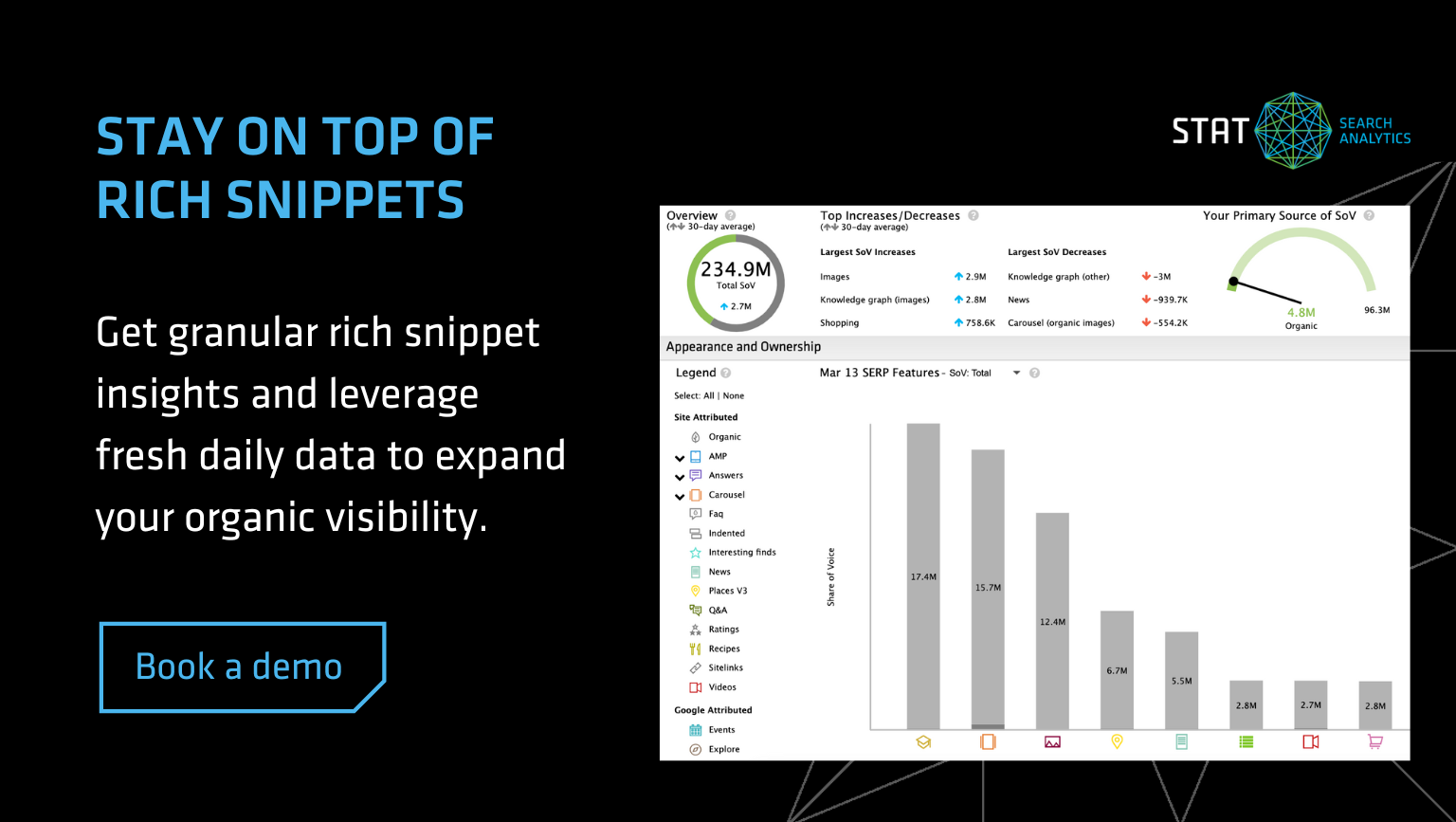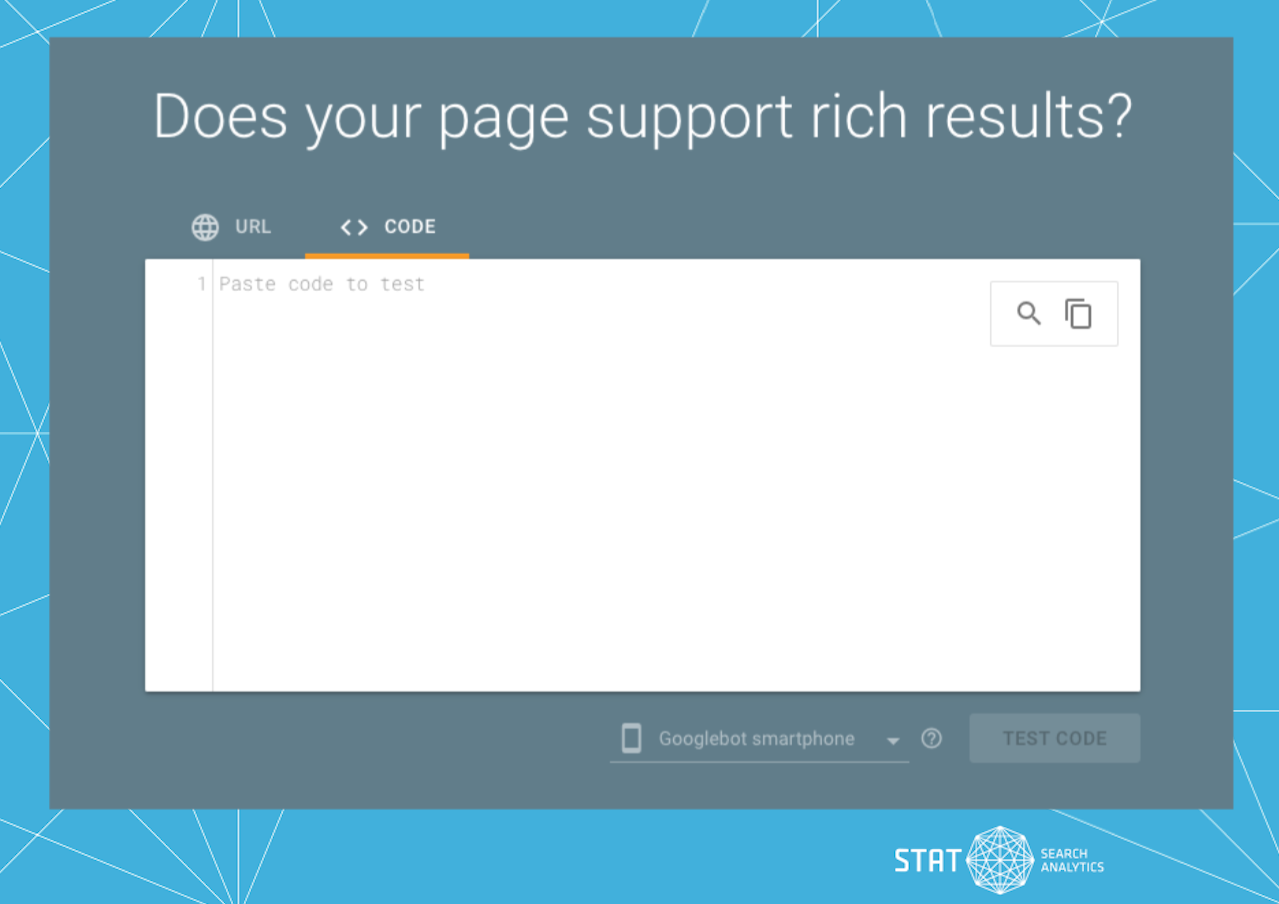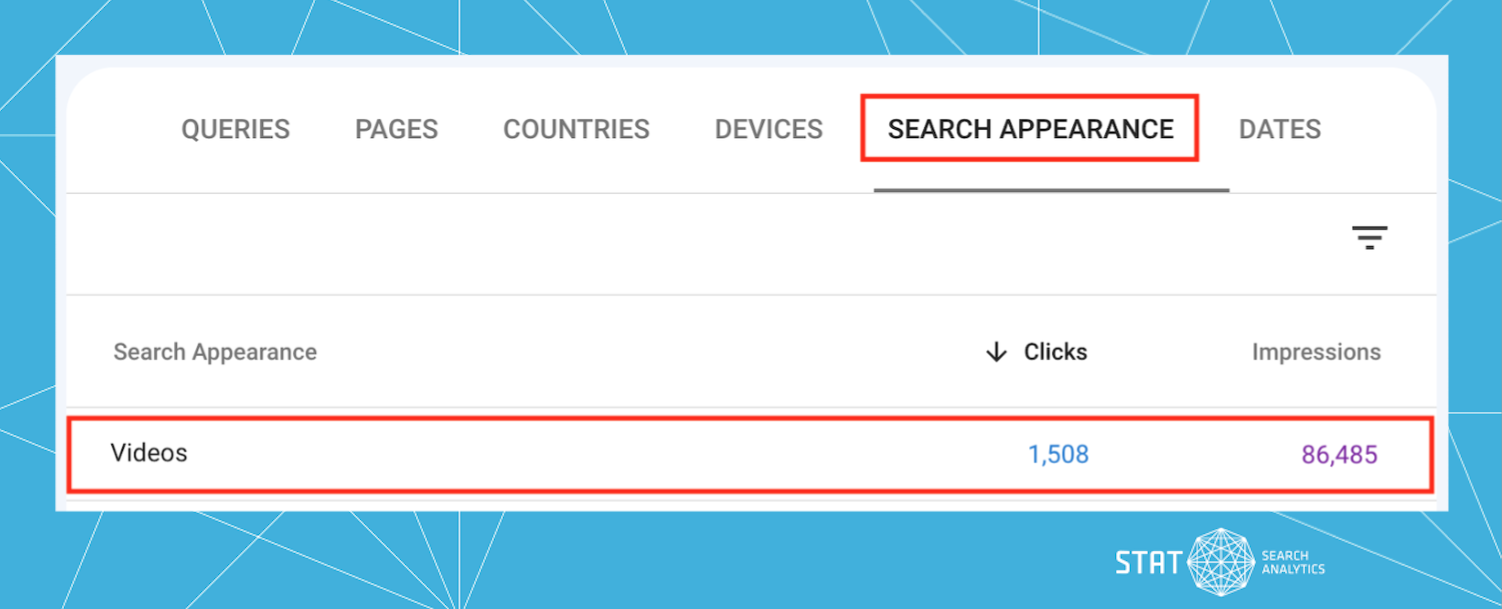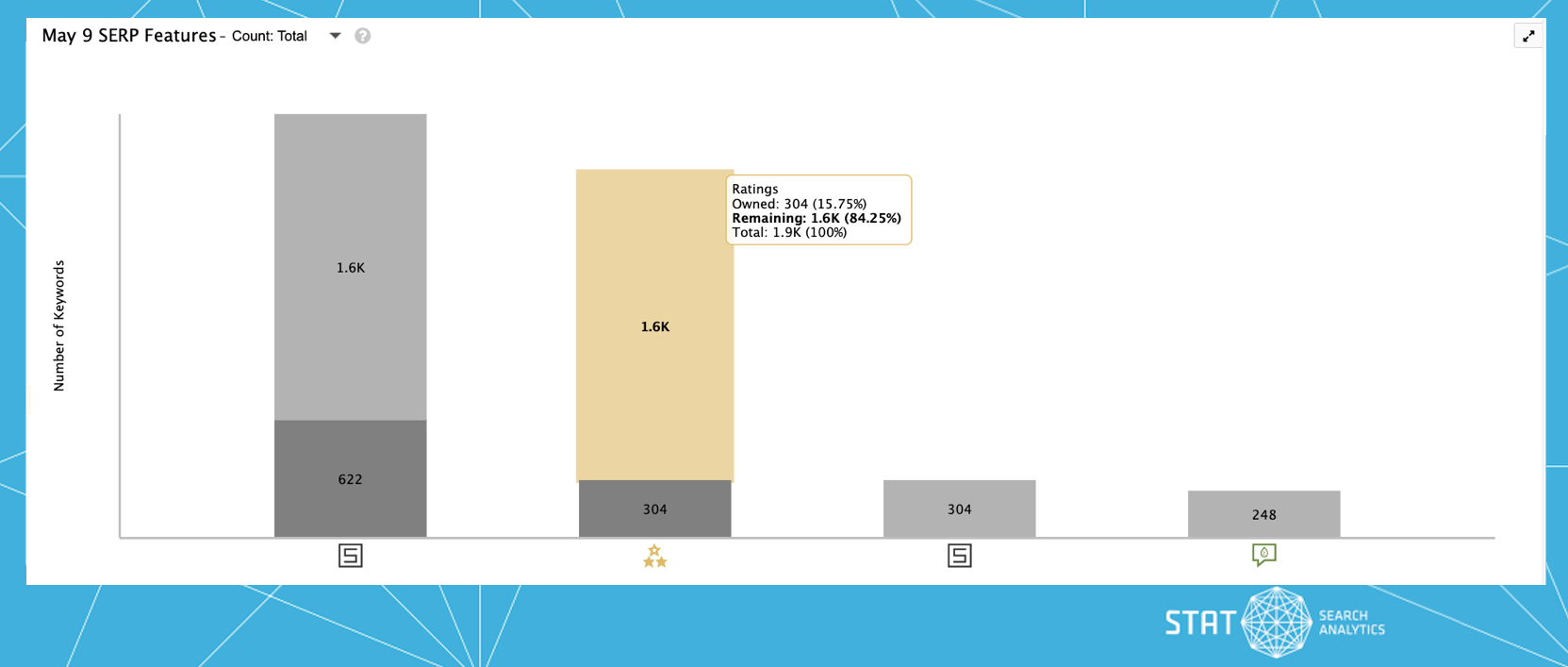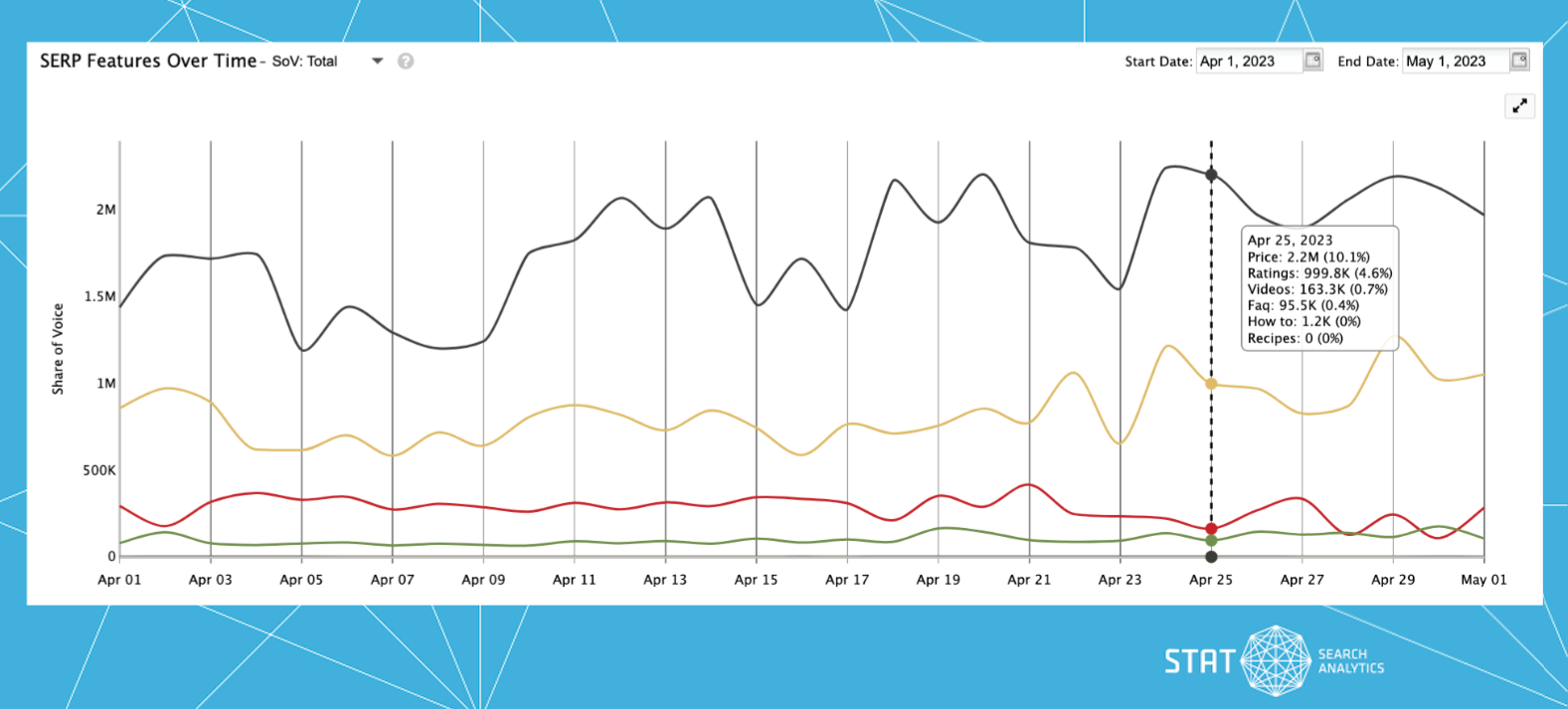Ensure you’re tracking rich result performance and building on successes to make the most of your organic rankings.
Rich snippets are a great way to add extra information for searchers on the SERPs and potentially increase your organic click-through rate (CTR). But with so many rich snippets to choose from, how do you keep track of the ones you’re surfacing and ensure that your site is optimized?
We’ve outlined a five-step process, calling out helpful tools you can use along the way, so you can get your rich snippet ducks in a row. From implementation and tracking to iterating on your approach, you’ll be able to measure your progress over time and build on your rich snippet successes.
The five steps to tracking rich snippet performance:
- Step 1: Identify applicable rich results & add structured data to your site
- Step 2: Test your structured data
- Step 3: Monitor rich result markup in Google Search Console
- Step 4: Leverage granular rich snippet insights from the SERPs
- Step 5: Track progress over time & iterate
Step 1: Identify applicable rich results & add structured data to your site
First things first. With so many possibilities for the types of rich results available, it’s worth taking the time to research the ones that are most applicable to your business.
We did some investigating of our own, digging into 560,000 SERPs to learn about rich snippet prevalence and see which types came out on top — and we surfaced some interesting nuggets of insight. Take a peek at our findings, but keep in mind that your keyword set will have its own quirks and nuances based on your industry and competitors on the SERPs.
A snippet from our rich snippet prevalence research
Ratings were clearly leading the pack in terms of prevalence amongst the rich snippet types we analyzed.
Once you’ve narrowed down the types of rich snippets you’re after, then you’ll need to add the required structured data to your website. Structured data is code that helps search engines understand the content on your site, and properly implementing it will ensure that your pages are eligible to display rich snippets in search results.
Here’s a quick guide on how to optimize for some of the more common rich snippets, with examples of the kinds of markup required to trigger them.
When you’re ready to take the plunge, be sure to utilize Google’s own Structured Markup Helper tool to generate the structured data you’ll need to add to the backend of your site.
Google's Structured Data Markup Helper
Technical SEO can be daunting. Luckily there are handy tools to help with the heavy lifting.
Step 2: Test your structured data
Once you’ve added structured data to your site, you’ll want to head over to Google’s Rich Results testing tool to ensure everything looks as it should.
Google's Rich Results Testing Tool
Take the guesswork out of the equation and double-check that your structured data is free of errors.
Enter your code from step one into the Code tab — or even run a URL with any already-added structured data through the URL tab — to test whether you’ve implemented it properly.
Once your test comes back indicating that your desired rich result markup is valid and you’ve added it to your site, it’s time to sit back, have some patience (it can take up to several weeks for newly implemented structured data to materialize into rich results on the SERP), and monitor your pages.
Step 3: Monitor rich result markup in Google Search Console
Google Search Console is an invaluable (and free!) tool for tracking the performance of your site in search results. If you’re not already set up, follow the prompts to get it verified and up and running for your site.
Once in, you’ll want to click into specific rich snippet types under “Enhancements,” where Google Search Console will pull in each eligible markup type that Google detects on your site. This will give a high-level view of your valid rich result markup and handily pinpoint any issues to troubleshoot and fix with alerts or warning messages.
Google Search Console
Filter by result type and quickly see the number of valid markup results showing for your site, as well as any error or warning messages.
You’ll also want to pay special attention to the Search Appearance report (where you can filter by specific result type) to see the clicks and impressions of any rich results appearing on the SERPs and monitor for any fluctuations.
Search Appearance in Google Search Console
Keep an eye on impressions and clicks for specific result types and gauge fluctuations in your click-through rates.
Step 4: Leverage granular rich snippet insights from the SERPs
Now it’s time to take your strategy to the next level and dive deep into the data behind the rich snippets surfacing for your keywords. You’ve seen what’s possible for your site, now you need to see what’s actually appearing on the SERPs for you and your competitors.
If you’re in STAT, you can surface this kind of data in the SERP features tab, easily tracking the performance of your optimizations over time to see exactly where you’re making the most impact.
Scope out rich snippets in STAT
See the total number of rich snippets surfaced for your keyword set and toggle between how many of them you own.
The key to getting the most powerful rich snippet insights is how you slice and dice your data into strategic segments. Set yourself up for success by creating dynamic tags based on filter criteria that tracks the total count, owned, and unowned rich results in your keyword set.
Dynamic tags for rich snippets in STAT
These handy active filters can help you slice and dice your data to stay on top of movement on the SERPs.
For example, in the screenshot to the left, these powerful filters show that of the total 2,238 keywords in our dataset triggering a price rich snippet, we own 622 of those, while 1,616 are owned by search competitors.
To see how stable the appearance of these rich snippets is, head to the SERP Features Over Time graph and toggle on Count: Total. In our example below, ratings and price are the two most prevalent rich snippets in this particular keyword set and remain incredibly stable in their appearance on the SERP over time.
Rich snippet appearance over time
You’ll be the first to know when there’s fluctuations in the prevalence of rich snippets on the SERP.
Next it’s time to add in another layer of analysis by toggling the same chart to show SoV: Total — this will show the share of voice connected to each rich snippet keyword.
What we can see in our example below is that our keywords with price and ratings snippets tend to drive more visibility than keywords with videos and FAQs; however, the share of voice of our ratings and price keywords fluctuates quite a bit, which means that either their rank or their search volume (or both) are going up and down and are more volatile than the other two types.
Share of voice for rich snippet keywords
Track share of voice driven by rich results over time to gauge their impact on your organic visibility.
With both pieces of information in hand, you can better prioritize the rich snippet types that are most prevalent and stable in your space, for the keywords that drive the most visibility and/or are the least volatile.
Your dynamic tags will also help you go toe-to-toe with your top search competitors (and potentially even discover some new ones). By digging into the keywords that your competitors are triggering rich results for but you aren’t, you can pinpoint gaps and identify keywords where you could be improving your organic visibility with rich snippets.
Keywords where competitors own rich snippets
Drill down into specific keywords within your dynamic tags to surface granular SERP insights.
Then hop into the Archived SERPs tab, which lists the different result types appearing at each organic rank for every competitor URL to help you reverse-engineer what competitors are doing. You can even see the expanded footprint of the rich snippets in question on the Full HTML SERP tab to get more granular insight on exactly what content is being pulled in for rich result types like FAQs or How tos.
Demystify rich snippets with eyes on the ground
With the Archived SERP and Full HTML SERP tabs, eliminate any uncertainties around how rich snippets are appearing in search results.
To do this competitive analysis at scale, look no further than the Top 20 Comparison report. Use your (you guessed it) dynamic tags to pull this report for SERPs containing the unowned rich snippets you’re interested in.
Since this handy spreadsheet export comes ready for filtering, you can hone in on high-impact opportunities by surfacing keywords with the highest search volume or zero-in on specific competitors by filtering for their URLs.
The Top 20 Comparison report
This powerful export allows you to slice and dice your data to hone in on prime competitive opportunities.
Step 5: Track progress over time & iterate
As the SERPs are always in flux, you’ll want to monitor progress over time and tweak your approach accordingly. Generally, surfacing more rich results can lead to an increase in click-through rate and can result in increased traffic to your site (hooray!).
And don’t be afraid to experiment with different rich result formats to see what resonates most with your audience. Ultimately, rich snippets are a means to an end — with the end goal being driving more users to your site.
This process is meant to be iterative, so be sure to re-evaluate your approach over time, building on successes and doubling down on what’s working, and pivoting where you’re not seeing the same gains. Since no industry or site is exactly alike, the twists and turns along the path to success will look different depending on your unique scenario.
Onwards to rich snippet success!
By now, we hope you’re feeling primed and ready to identify the rich results beneficial to your site, generate their required structured data, QA your code, and monitor the impact of your optimizations.
If you’re not yet using STAT to help with this kind of work and want to see it in action, give us a shout and we’d be happy to show you around.
Now get out there and snag some rich snippets!
